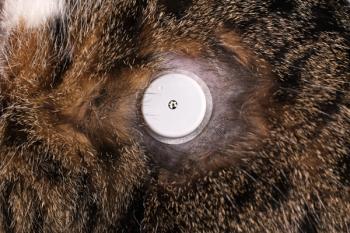
Atypical hyperadrenocorticism (Proceedings)
Naturally occurring hyperadrenocorticism (HAC) is an endocrine disorder resulting from the excess production of cortisol or other adrenal hormones by the adrenal cortex. The clinical syndrome was first documented in people by Dr. Harvey Cushing in 1932 and is also known as Cushing's syndrome.
Naturally occurring hyperadrenocorticism (HAC) is an endocrine disorder resulting from the excess production of cortisol or other adrenal hormones by the adrenal cortex. The clinical syndrome was first documented in people by Dr. Harvey Cushing in 1932 and is also known as Cushing's syndrome. Hyperadrenocorticism in dogs is one of the most common endocrinopathies in small animal practice, and it is also one of the most complicated to diagnose, treat and monitor clinically. This session will focus on what is currently referred to as the atypical form of the disease. This is a somewhat controversial area as there are still many unknowns associated with what is referred to as atypical HAC.
Pathophysiology
HAC is caused by either excess adrenocorticotropic hormone (ACTH) production due to a pituitary adenoma leading to pituitary-dependent hyperadrenocorticism (PDH) or a functional adrenocortical tumor (AT) independent of pituitary control. Historically, the clinical signs associated with the disease were attributed to the excess of cortisol secreted by the adrenal glands. It is now realized that the clinical syndrome can also be caused by excesses of other adrenal hormone(s) in the cascade. Hormones that may be involved are androstenedione, estradiol, progesterone, 17-hydroxyprogesterone (17-OHP), and aldosterone. It is suggested that these cases have a derangement of the steroid production pathway and that some of the precursors of cortisol, such as 17-OHP may be abnormally increased. In some instances cortisol may in fact be measured below the normal range, which can confuse the diagnosis.
Diagnosis
Diagnosis of atypical or the classic form of this disease is based on the combination of clinical signs, typical findings on routine lab work and urinalysis, and results of specific screening and differentiating tests. It must be kept in mind that all of the potential screening tests and differentiating tests have important limitations, and therefore there is the possibility of false positive tests and false negative tests frequently. All clinical signs, routine test results, and specific test results must therefore be assessed in conjunction to obtain an accurate diagnosis. Testing may lead to a diagnosis of PDH or AT, and specifically which hormone(s) is abnormal.
Screening and Differentiating Tests
Routine testing may include performing some or all of the following: the urine cortisol to creatinine test (UCCR), the ACTH stimulation test and the low dose dexamethasone suppression test (LDDST). The UCCR has a high sensitivity (85-100%) and a low specificity (20-25%). Because of the low specificity, the UCCR may be used to rule out HAC but not rule in HAC. A positive result indicates the need to perform an additional screening test. In cases of Atypical HAC, the cortisol levels are not necessarily elevated. The ACTH stimulation test measures the adrenal gland response to injected ACTH or synthetic analog. The sensitivity is between 60-85% and the specificity is between 85-90%. Post stimulation cortisol levels above 22 ug/dL are consistent with HAC. The ACTH stimulation test function is to diagnose or rule out hyperadrenocorticism and does not differentiate PDH from AT. Some dogs with HAC can have normal measured cortisol levels and in Atypical HAC the cortisol levels may be normal or low, but other hormones are elevated. The LDDS test may differentiate PDH and AT. Cortisol secretion is sometimes suppressed at 4 hours and then escapes to above normal concentrations at 8 hours with PDH. In 40% of the cases the suppression does not occur due to dexamethasone resistance. The high dose dexamethasone suppression test (HDDS) is also used to differentiate PDH and AT. Nearly all AT cases fail to suppress cortisol in HDDS test. In PDH cases suppression does occur in approximately 80% of the cases. If cortisol suppression occurs the dog likely has PDH but if no suppression occurs, the dog is more likely to have AT. Measurement of endogenous ACTH concentration may differentiate PDH from AT. ACTH is suppressed in dogs with AT. ACTH is normal to elevated in dogs with PDH.
Additional Testing
Imaging can help support the diagnosis of HAC. AT can cause calcification of the adrenal gland which can be seen on abdominal radiographs. Ultrasonography can be used to differentiate PDH from AT. In PDH, the adrenal glands are usually bilaterally symmetrically enlarged. Typically with AT, the affected adrenal gland is irregular and the contra-lateral adrenal gland is smaller. If the finding is typical, ultrasound is helpful, but there are many instances where there is an asymmetry such that definitive conclusions cannot be drawn, and differentiation must rely on additional testing. A CT or MRI is needed to visualize a pituitary tumor.
Clinical Indications for Adrenal Steroid Hormone Profiles
Steroid hormone profiles are indicated when the routine tests of adrenal function are normal but clinical signs are consistent with the disease, and there is no evidence for another cause for the disease. Steroid hormone measurements of cortisol, androstenedione, estradiol, progesterone, 17-OHP, and aldosterone are available (College of Veterinary Medicine University of Tennessee). Baseline measurements and post ACTH stimulation results are reported. Elevation in one or more of these hormones indicates the presence of increased adrenal activity. Abnormalities of 17 OHP levels have been reported most commonly, and this test is available individually through a variety of laboratories. Evaluation of ACTH stimulated 17-OHP is considered to be useful if other screening tests are equivocal, but not as a first line screening test. There are many instances where this hormone can be elevated, in the absence of HAC; therefore results have to be interpreted with caution and in light of the entire clinical picture.
Therapy-Medical Management of PDH
For PDH, whether atypical or classical form of the disease, medical management is generally considered in this country. The decision generally is between mitotane and trilostane for most PDH cases. There is still controversy over some aspects of this decision and which is the best choice.
Mitotane is a potent adrenocorticolytic (cytotoxic) agent. Monitoring of clinical signs is crucial during therapy of with mitotane, to try to prevent irreversible damage and life threatening side effects. Some common side effects include gastrointestinal upset, hypocortisolism (gastrointestinal signs, weakness, and hypotension) and neurologic signs. These signs can range from mild to severely life threatening.
Trilostane is an alternative that is currently very popular for therapy of HAC. A veterinary formulation has recently been FDA approved for canine HAC. It is an inhibitor of 3 B hydroxysteroid dehydrogenase and therefore blocks the production of cortisol, as well as other adrenal steroids. Several intermediary hormones may actually be elevated during therapy with trilostane though, and this must be considered when choosing this therapy. This may occur in the face of good clinical improvement, and the reasons for this are not fully understood at this time. Trilostane has a relatively short half life, and therefore must be administered daily for the rest of the dog's life. There is controversy whether the dosing should be once or twice daily. Adjustments in dosing are based on ACTH stimulation test results. Side effects and incidents of side effects are similar to that with mitotane. It was thought that the side effects would be fewer with this drug, but there is some discrepancies regarding this information, and some evidence that side effects are equally frequent. When comparing long-term survival in dogs with HAC, there is not a significant difference between these two treatment options.
There are some other potential therapeutic options that have been suggested as alternative therapies. Melatonin is an option. It inhibits the 21 hydroxylase enzyme and may be indicated, depending which intermediary hormones are elevated. Flax seed oil with lignins is also an option. This is thought to inhibit the 3 beta hydroxysteroid dehydrogenase enzyme and may be beneficial in certain circumstances. There have been no controlled clinical studies regarding dose and efficacy of these alternatives.
Monitoring therapy is extremely important no matter which therapy is chosen. This should include monitoring physical examination, clinical signs, ACTH stimulation tests, blood pressure, appetite, water consumption, electrolytes, and blood chemistry values.
Therapy- Management of AT
In dogs with AT, whether typical of atypical, the treatment of choice is usually surgical resection. Although some cortisol-secreting adrenal tumors do respond well to medical therapy with mitotane or trilostane, noncortisol-secreting tumors tend to respond poorly to medical management with either drug.
References available on request
Newsletter
From exam room tips to practice management insights, get trusted veterinary news delivered straight to your inbox—subscribe to dvm360.




